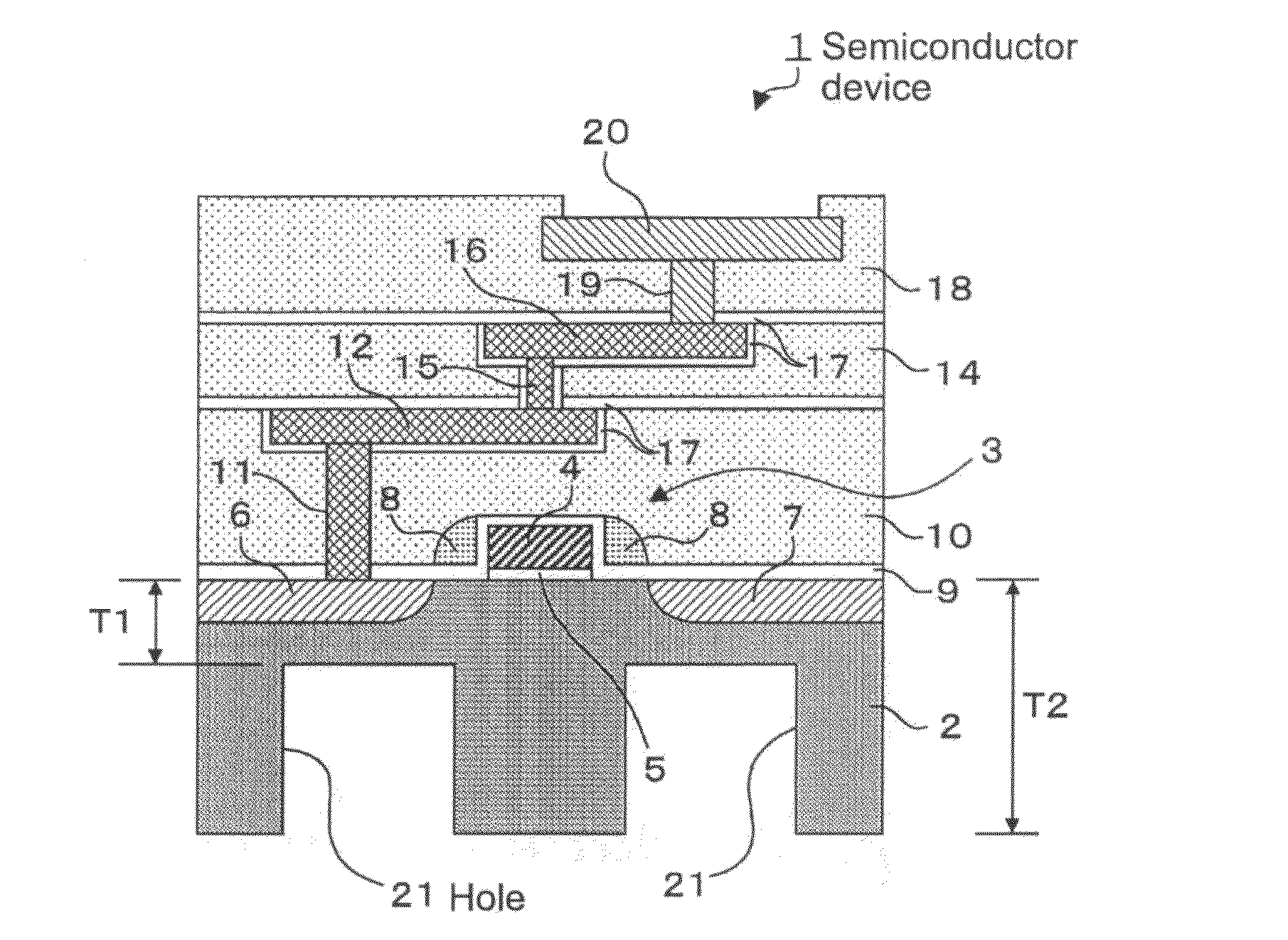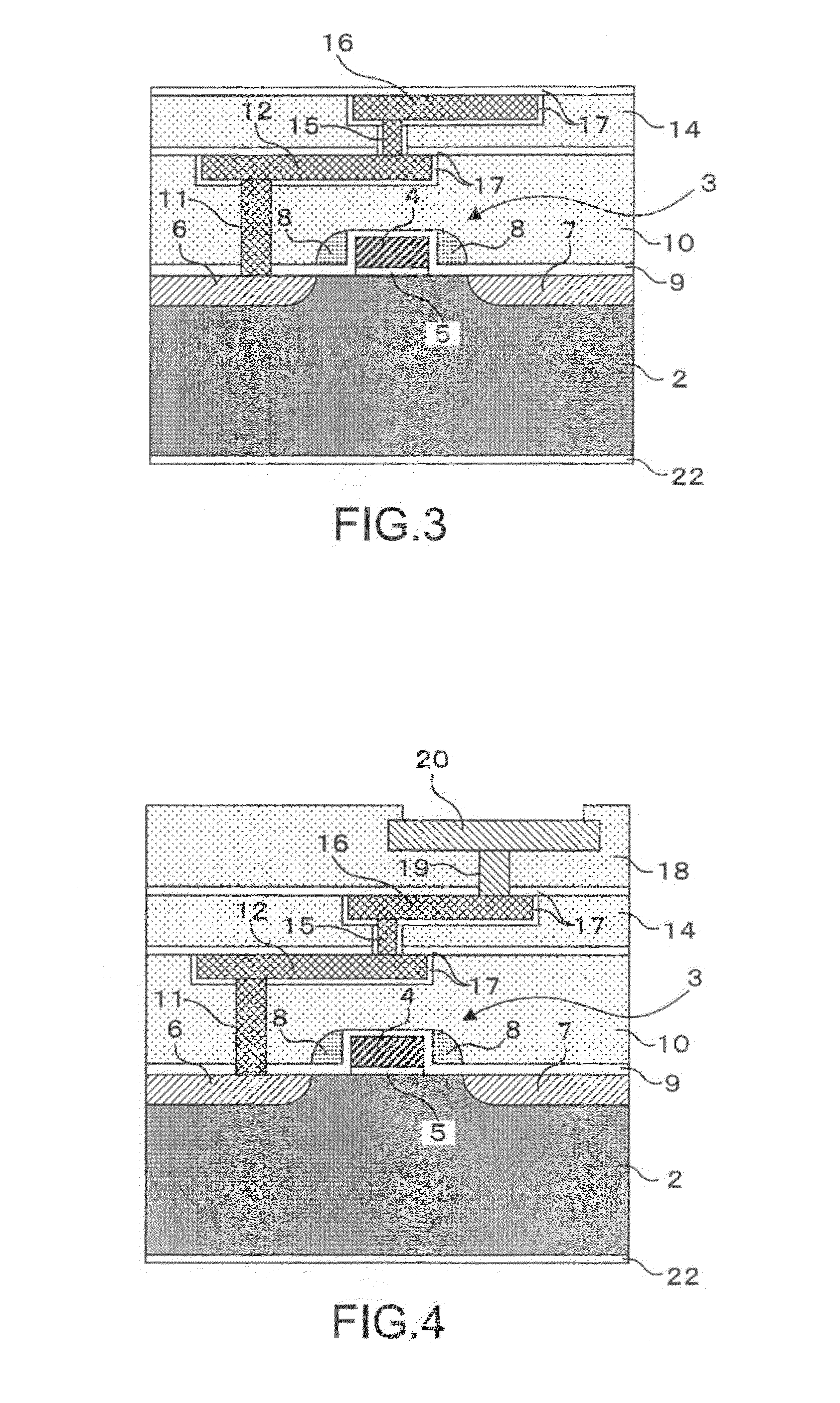Semiconductor device, method of manufacturing the same, and electronic apparatus
- Summary
- Abstract
- Description
- Claims
- Application Information
AI Technical Summary
Benefits of technology
Problems solved by technology
Method used
Image
Examples
first embodiment
1. First Embodiment
(Structure of Semiconductor Device)
[0043]FIG. 1 is a cross-sectional view showing a structure of a semiconductor device according to a first embodiment of the present invention. A semiconductor device 1 shown in FIG. 1 includes a semiconductor substrate 2 as a device substrate. The semiconductor substrate 2 is formed of a silicon substrate that is a P-type semiconductor substrate. On a first surface (upper surface) of the semiconductor substrate 2, a transistor is formed. The transistor 3 is constituted of a gate electrode 4, a gate insulating film 5, a source region 6, and a drain region 7. The gate electrode 4 is formed on the gate insulating film 5. The gate electrode 4 is made of polysilicon, for example. The gate insulating film 5 is intervened between the gate electrode 4 and the semiconductor substrate 2. The gate insulating film 5 is made of a silicon oxide film, for example. On both side surfaces of the gate electrode 4, sidewalls 8 are formed. The source...
second embodiment
2. Second Embodiment
[0058]FIG. 10 is a cross-sectional view showing a structure of a semiconductor device according to a second embodiment of the present invention. The semiconductor device 1 shown in FIG. 10 includes a glass substrate 25 as a device substrate. On a first surface (upper surface) of the glass substrate 25, a polysilicon thin film 26 is formed. On the polysilicon thin film 26, the source region 6 and the drain region 7 of the transistor 3 are formed. In a second surface (lower surface) of the glass substrate 25, a plurality of holes 27 are formed under the same condition as in the case of the semiconductor substrate 2 described above. The plurality of holes 27 are formed for the same purpose as the holes 21. The other structure, basic manufacturing processes (manufacturing method), and operations and effects are the same as in the first embodiment, and therefore their descriptions will be omitted. It should be noted that the glass substrate is used as the device subst...
third embodiment
3. Third Embodiment
[0059]FIG. 11 is a cross-sectional view showing a structure of a semiconductor device according to a third embodiment of the present invention. The semiconductor device 1 shown in FIG. 11 includes an SOI substrate 28 as a device substrate. The SOI substrate 28 is constituted of a silicon substrate 29 as a base, a BOX oxide film 30, and a crystalline silicon thin film 31. The BOX oxide film 30 is formed of a silicon oxide film. The BOX oxide film 30 and the crystalline silicon thin film 31 are formed on a surface (upper surface) of the silicon substrate 29 in a laminated manner in the stated order. Of those, in the crystalline silicon thin film 31, the source and drain regions 6 and 7 of the transistor 3 are formed. Further, on the other surface (lower surface) of the silicon substrate 29 corresponding to the second surface of the SOI substrate 28, a plurality of holes 32 are formed under the same condition as in the case of the semiconductor substrate 2 described ...
PUM
 Login to View More
Login to View More Abstract
Description
Claims
Application Information
 Login to View More
Login to View More - R&D
- Intellectual Property
- Life Sciences
- Materials
- Tech Scout
- Unparalleled Data Quality
- Higher Quality Content
- 60% Fewer Hallucinations
Browse by: Latest US Patents, China's latest patents, Technical Efficacy Thesaurus, Application Domain, Technology Topic, Popular Technical Reports.
© 2025 PatSnap. All rights reserved.Legal|Privacy policy|Modern Slavery Act Transparency Statement|Sitemap|About US| Contact US: help@patsnap.com



